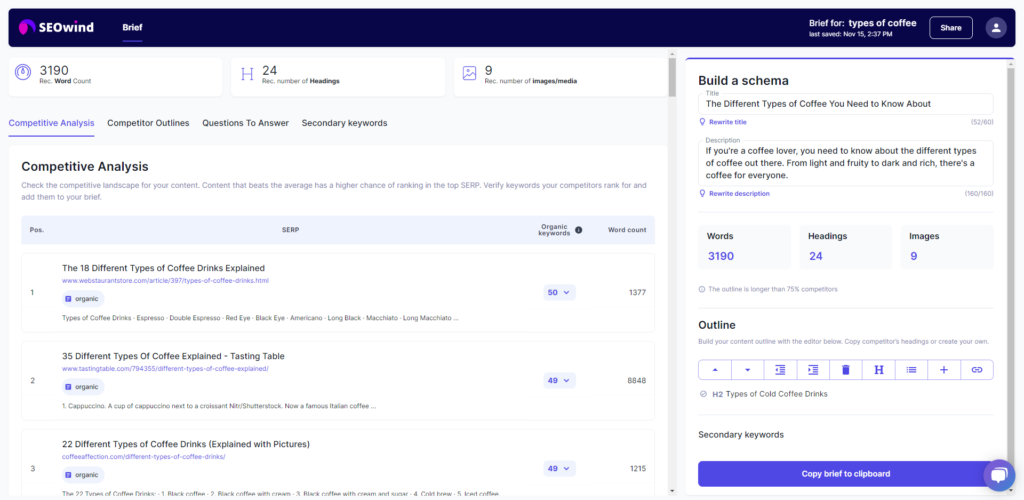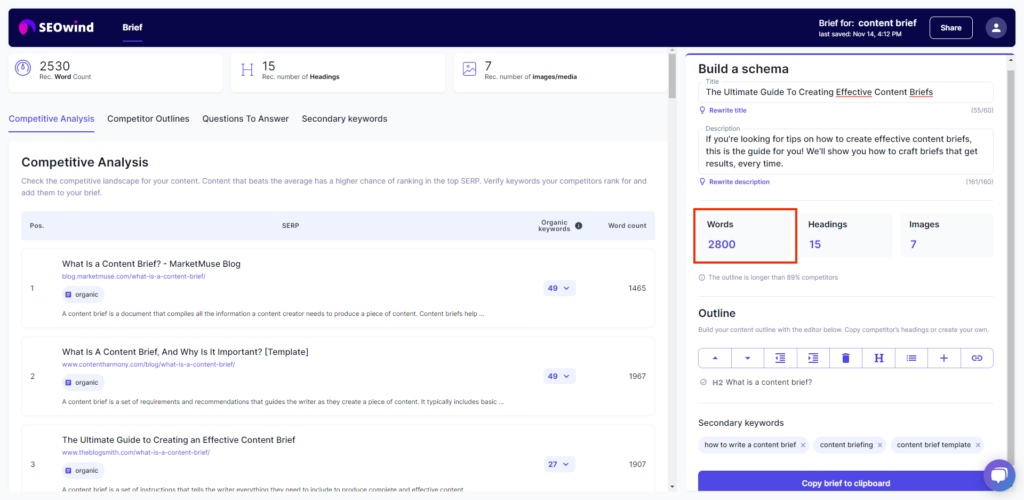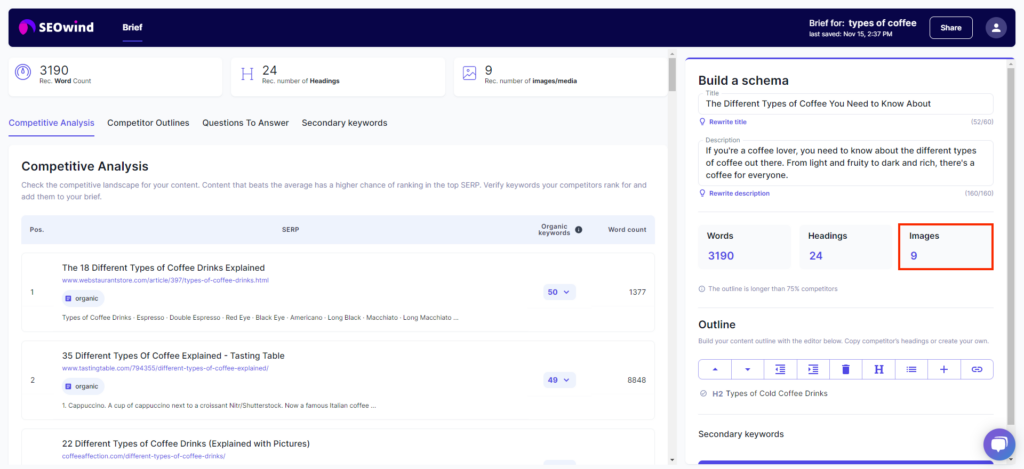What is SEO content writing, you ask?
One thing I’m sure of. You need it and there’ll you find out how to do it!
If you want your website to rank high in the search engines, quality SEO content creation is a must. Writing great content isn’t enough anymore. Most of all, you need to make sure your content is optimized for SEO.
The dilemma might appear, am I writing more for humans or search engines?
The answer is simple. Write for humans first and search engines second!
Writing for SEO means writing content that is valuable to users. In other words, when you write for people, you’ll naturally find that your content ranks higher because it is the most relevant and provides the best information. Search engines rank pages that provide the best user experience. For this reason, pages with high-quality and engaging content will get ranked higher than their competitors.
Taking into account search engine optimization can help you a lot though. SEO writing is writing targeted toward search engines to help them understand what a page is about and how it will be useful to readers.
SEO writing can be a difficult skill for those who are unfamiliar with the concept of it.
The good news is that SEO is not an art, it is more of a science.
Wanna go deeper and understand how to do it?
In this ultimate guide, we’ll teach you everything you need to know about writing content for SEO. We’ll discuss what SEO writing is, and how to write effective content that ranks well in search engines. Consequently, you will get a detailed walkthrough through the process as well as SEO technicalities.
So buckle up, let’s start!
TL;DR
- SEO writing is designed to appeal to search engines while also appealing to particular search queries and thus people.
- SEO content is any form of content on a website created to improve the site’s search engine ranking.
- SEO copywriting refers to a particular version of writing that takes into account the implementation of keywords and key phrases within web content, along with some SEO ground rules, emphasizing persuasive language and transactional words.
- High-quality content with on-page SEO is a great way to get more traffic from Google.
- SEO writing helps to create content that your audience needs, wants, and values, ultimately targeting and interesting them in what you have to offer.
- SEO content creation is imperative if you want to increase your website’s appearance in search results.
- Optimized content can also help improve brand awareness for your company.
- To write effective SEO content, you should research your audience’s interests, determine search intent, and identify the right format.
- Keyword research is crucial to the SEO writing process to ensure that the right keyword is targeted and gets hundreds of visits each month.
- Make sure to structure your content with headers, subheaders, and paragraphs to make it more readable.
What is SEO content writing, anyway?
SEO writing is writing that aims to meet the needs of people who are searching for information at Google, using SEO techniques including implementation of keywords and key phrases within the content. In other words, SEO writing aims to attract search engines and match specific search queries people have.
The goal is to make sure content focuses on what the user wants, not just what you want. This means getting to know your users, as well as making it easy to read, attractive, and shareable. The content should be clear and concise so that people can find their answers quickly before moving on with their lives.
What kind of content writer do you need: an SEO Expert or a great Copywriter?
When it comes to creating content, there are two main types of writers: SEO experts and great copywriters. While both types of writers are skilled in crafting engaging and informative content, they have different specialties and approaches. For us, this choice is pretty simple.
What is SEO content vs SEO copywriting?
SEO content is any form of content on a website created to improve the site’s search engine ranking. SEO content can take various forms. It can be blog posts, articles, videos, eBooks, webinars, infographics, slide decks… you name it.
SEO copywriting involves creating web content that incorporates keywords and key phrases in line with SEO principles, while also using persuasive language and transactional words to engage readers.
In other words, traffic that is driven by Google for your business typically won’t come from simply having great “SEO content”. You need engaging, catchy SEO copywriting that tells the story about what you offer. This will be able to better articulate what you’re selling than just listing out items on your page without rousing interest creatively.
Why Is SEO Writing Important?
If you want to increase your website’s appearance in search results, then it is imperative for SEO content creation.
In simple words you can look at SEO writing meaning in the following way:
High-quality content + on-page SEO = SEO writing & <3

Using high-quality content with on-page SEO is a great way to get more traffic from Google. On-page SEO means optimizing your website for search engines, which can be done by making sure that everything about your site – both in terms of content and coding – includes the various factors that search engines will look for when indexing it.
There are quite a few important benefits of writing for SEO.
1. Create content that your audience needs, wants, and values
If you include an SEO approach in your content efforts you will make sure that you are writing about the topics that interest your audience. This way it allows you to create value for them. Ultimately, it will enable you to target and interest them in what you have to offer. You can tailor your content to address the needs of these readers, which will help increase your conversion rate.
2. Increase organic visibility, SERP rankings, and traffic
If you are writing your content taking into account SEO then you can be sure that your content will be easier found by Google and thus it will drive more traffic. Simple as that.
3. Improve brand awareness for your company
Lastly, optimized content can also help improve brand awareness for your company.
Know your audience, start with why, and have a goal in mind
Let’s jump to writing straight away!

No, WAIT! STOP whatever you’re doing now.
You can’t just wax poetic willy-nilly without first conducting keyword research and obtaining audience insights. The objective is to generate qualified and targeted visitors, right?
Do your homework first!
Otherwise, you will be writing just for writing, not even knowing whether it brings any value to anybody.
Research the topics
It might sound counterintuitive but before you start writing a single word you need first to investigate what the topics are that your audience is interested in, you need to determine how you can serve them and bring value.
Below you can find a couple of ways to do it:
- Quora and Reddit Questions
- Answer The Public https://answerthepublic.com/
- Investigate the top 10 SERPs
Know why you are writing the content
Determine search intent and identify the right format.
The primary goal of SEO content is to get people to find your website through search engines while providing value to the user. Search intent can be defined as why a user is searching for. Is the intent informational, commercial, or transactional? Based on it the format, language, and content will be different.
Let’s analyze the following example.
People are searching for “meeting scheduling software” – they are interested in learning about the best options out there. Here you can answer their question with content using words such as “guide”, “tutorial”, “what”, “how”, “when”. You can provide valuable information that will broaden their knowledge around certain topics.
However, if the person is searching for “meeting scheduling software online for SME” the content will be much different as they are further in their decision-making process. As a result, the content of the article could discuss the different types of meeting scheduling software, their advantages/disadvantages, and what features you should look for when deciding to purchase one. This article would be valuable to someone who is trying to figure out which product they should purchase.
Do keyword research
The most crucial step in the SEO writing process is keyword research.
The right keyword can make all of the difference between hundreds of visits each month… or a piece of content that no one reads (maybe not no one but only your friends and family).
Therefore we recommend picking one primary keyword and then digging deeper. The primary keyword should be your main focus.
There are a few things that you need to consider when choosing keywords:
1. What are people searching for?
2. What are the keywords that your target audience is using?
3. What are the long-tail keywords that your target audience might be using?
How to choose a primary keyword from a technical perspective?
SEO tips regarding keywords:
- High-volume keywords are popular, but they are also challenging to start ranking for in the short term due to keyword difficulty.
- The Keyword Difficulty indicator takes into account the domains appearing in the top 10 SERPs’ authority and backlink profiles, as well as data about the keyword itself, such as the kind of keyword, search volume, search intent, and SERP features.
- Keyword difficulty varies depending on the sector you work in. Some industries may have high volumes with low difficulty, while others have lower volumes but higher difficulties. It is determined by your niche! Always verify!
You shouldn’t limit yourself to only one primary keyword. Try targeting a couple of related keywords (secondary keywords) as well. These can be so-called long-tail keywords.
You don’t expect an article to rank if you only use one keyword. Google wants a variety of signals that demonstrate content relevance, so including keyword variants is a good way to tell Google how your material should be interpreted.
Helpful tools to do keyword research:
Outline Content To Match Search Intent
Once you know what is your target audience, what are they searching for, and what kind of topics is interesting to them, you can draft a content outline. It will serve as a roadmap that will guide you to cover all the relevant questions, subjects, and issues to fully answer the questions your audience has.
Use content writing tools like SEOwind to speed up the process
You can either do the whole research manually, using various SEO tools, or use software like SEOwind to gather all the SEO data for you and prepare the comprehensive SEO Content Brief.
SEOwind analyzes:
- Top SERPs regarding their outline and keywords they rank for
- Commonly asked questions, collected from People Also Ask and Quora
- Topics and secondary keywords worth using.
It also gives you recommendations regarding a number of words, headings, and images. All the recommendations are based not on guessing but on data, meaning that it is relevant for the particular keyword you would like to rank for.
You can also get suggestions on the title and description, to make your work easier.

Write Comprehensive Content
Now that we know what is our target audience, how they behave, and what they are looking for, we can start writing!

Yeh, finally!
Google wants to provide users with the best possible results when they search for something. This is where comprehensive blog posts come in useful since they offer more information than ever before.
The problem with most small-space blog posts is that there’s not enough room for real depth and enough opportunities to get into too much detail. Longer, more comprehensive articles answer the question as opposed to just scratching the surface.
Make your text as long as necessary. “Long reads with 3000+ words receive 3x more traffic, 4x more shares, and 3.5x more backlinks than short pieces (901-1200 words)” (source: Semrush). However, this does not imply that a short article will never rank well.
Testing is the key!
Though long-form content ranks best in Google you should still put the value first.
We often get the following question: how long should a blog post be for SEO?
There is no good answer to the question of How long my post should be. Check the top SERPs and adjust your text length accordingly. The comprehensive text might mean in one case 1.500 words and in another 3.000 words. There is no one good answer.
👉 When creating a Content brief in SEOwind we are analyzing the top SERPs for the chosen focus keyword. This way you can make a cautious decision about how long you want your content against the content that is already ranking.

Use multimedia in your content
Another way to make your content engaging and add value is to include visual content.
It could be an infographic, a video, a checklist, a template, or just some great images or gifs.
The best way to use multimedia is to relate it to the text and make sure that it’s not just there for the sake of having a video/image. Different visual content across a page can help you convey information to the user better and strengthen your key message.
SEO tips regarding images:
- Reduce the image size
- Create descriptive image names (don’t name your images “IMG6512931.jpg” – it doesn’t convey any meaning)
👉 Wondering how many images should you include in your content? A good practice is to have the visuals at least every 500 words. This will ensure your content is easy to screen and consume. You can also check top SERPs for the chosen keyword to see how many visuals they include. It can serve as a good benchmark. At SEOwind we are including this data when conducting SEO analysis and making recommendations based on it. Just have a look below.

How to write SEO content – keywords guidelines
Now that you know how to write content for your audience, it’s time to learn a little bit about on-page SEO.
Including keywords in your content is one way to help Google understand what your content is about.
When you include keywords in your content, you’re not just targeting one person – you’re targeting everyone who is searching for that keyword.
Below you can find the most common questions regarding SEO writing and keywords:
How many times should I use a keyword in my content? Keyword frequency
There is no magic number primarily because there isn’t a number!
Search engines like Google don’t rank sites by counting the number of times a keyword appears, they rank them according to how relevant those pages are to search terms people use.
So write for the end-user! Not a magic number of keywords!
Avoid keyword stuffing. It is perceived by Google as spammy!
This is important to consider when crafting your content. Too many occurrences of keywords can be off-putting and distract from the answer. Still, there’s a range that you’ll need to find for yourself depending on your audience and context as you still want to indicate that you are writing on a particular topic.
Aside from SEO ranking factors, keyword frequency has been shown in some studies to have some correlation with click-through rates, so it pays to experiment with varying levels of keyphrase density in your content.
You need to keep in mind that search engines like Google rank pages based on keywords and the competition for those keywords. That’s why you should use your target keyword throughout your content and make sure it is mentioned a few times. I recommend having 3-5 mentions of your main keywords throughout an article.
Where do I use keywords in my content?
Based on my experience, the location of the keyword is even more important than the keyword density.
SEO tips for using primary keywords – use it in:
- your URL
- your title tag (use it only once, otherwise it will sound unnatural and may be perceived as stuffing activity)
- the first 100 words of your page
- an H1 tag
- an H2 tag
Remember:
- Search engines use titles to understand whether the content is relevant to the query. However, don’t over-optimize.
- Use keywords throughout your article.
What if a Keyword Phrase Doesn’t Sound Natural?
Sometimes, you will go for a keyword phrase totally unlike what you would use every day. That’s because people type into Google whatever comes to their mind first, often in its most simplistic form. For example, someone looking for information regarding how to write SEO articles will simply type “SEO content writing”.
This may be tough for SEO writers since articles must seem natural and engaging.
There are a couple of ways out here:
- Find a way to use it in a pure form so that it sounds as natural as possible. In our case, it can be a heading such as “SEO content writing essentials.
- Good news! There are many short words and phrases that search engines tend to overlook. Prepositions and articles (e.g., words like “of,” “a,” “in,” and “on”) are frequently neglected entirely. This may transform a poor keyword into something more natural.
Regardless of the technique you use, your keywords must always be grammatically appropriate within the article’s text. Over time, unnatural-sounding keywords with poor grammar will become more and more distinguishable to more advanced search engines.
Additional layer – topics
Think of them as related terms that search engines use to understand the deeper context of a webpage.
You might ask how do I find semantically related words to use in your content? Look into the following sources:
On-Page SEO: Title Tags, Meta Descriptions, & Alt Tags
Metadata is often disregarded by website owners, but it is still one of the most important on-page SEO ranking factors.
The meta description is the text that appears under a page’s title in Google results. If you create it effectively, it may be the difference between getting a user to click on your link rather than your competitors’.

Title tags
According to this case study published on the Moz blog, organic click-through rate is a Google ranking signal.
Your title tags are a critical part of your website’s SEO. They tell search engines what your pages are about and help them rank you in search engine results pages (SERPs).
Title tags are the titles of the listings you see in the SERPs (search engine results pages) and they let both search engine bots and potential visitors know what to expect on your page.
SEO tips for title tags:
- Put the keyword first, before anything else.
- Keep it as close to the character limit (55 or less) as possible.
- Make it clear and simple.
- Keep far away from keyword stuffing!
- Each page should have a unique title tag – no duplicates.
- Make it attractive by using a number in a title or crafting an intriguing and emotionally packed title
Competitor analysis is also useful. Google the term you want to include in your title tag; if all of the top results have it first, it’s probably a good idea to incorporate it there as well. It might also suggest that the current format is one that Google prefers.
Meta descriptions
In the search engine results pages (SERPs), meta descriptions are snippets of text that appear under the title tags. An eye-catching meta description may improve your organic click-through rate.
This is the place where you can describe what your visitor will find on the webpage and convince them to click through your website.
SEO tips for meta descriptions:
- Keep it short, between 140 and 160 characters. Although there is no restriction on how long a meta description may be, search result snippets are typically shortened to match the device size.
- Keep it clear & concise
- Your meta description should describe the specific page
- Include the primary keyword (usually the same or other versions of the one used in the title tag)
- Include a CTA (call-to-action) – Use click-worthy wording rather than regurgitating previously published material.
Alt tags
Alt tags (alternative tags) work similarly to title tags but are used for images or videos. While they don’t appear in the SERPs, search engine bots use them to find your keywords. They are utilized by both crawlers and screen readers. Given these points, you should be as descriptive as feasible while maintaining them short – consider them a sort of detailed file name.
SEO tips for alt tags:
- Use relevant keywords that relate to your post’s topic.
- Use descriptive language that closely matches the image. This will help Google Image Search rankings and provide additional information about how it relates to the content on your website.
- Avoid repetition, keep it natural. Write distinct alt text for each image that describes the picture’s content rather than repeating the main target keyword or other images’ alt tags.
- Keep it to 125 characters or less, with tags separated by commas.
Make your URL readable
A quality URL is one that clearly describes the page’s content to assist your visitors to understand what they will find there. URLs should be clear and descriptive to improve crawlability and understandability by search engines.
SEO tips for quality URLs:
- Use hyphens (-) instead of underscores (_) between words in your URLs, and don’t forget to use punctuation.
- Make your URL descriptive and match the page’s primary keyword.
- Lowercase is the way to go, rather than combining capital letters.
- Reduce it to the shortest length that will still describe the page’s contents.
Let’s take this article as an example. We gave it the following URL: seowind.io/seo-content-writing
Use internal links
Having a solid internal linking structure ensures that you direct visitors and search engines to important, relevant pages with additional information.
Internal linking helps search engines as well as people.
Google sends robots to find your site and to add it to the site database. They find web pages and then follow links to find new URLs. Interlinking is a way for search engines to discover relevant content on your site. Besides showing the structure of your site and giving relevant content, links to other pages pass authority. If a page has authoritative external links, it will have built up a PageRank score. This authority can be passed to another page on your site by way of internal links.
For users, interlinking is a way to find and navigate your website to find more helpful and relevant information.
Win-win for people and search engines.
SEO tips for internal links:
- Link to pages with relevant content – don’t just use your keywords for the sake of it
- Make sure the anchor text (the text you use as the link) makes sense
- Include the primary keywords in the anchor text, as well as other relevant SEO keywords
- Use at least 4-5 internal links for every article you publish.
Link to external pages and resources
Don’t link out to just anyone – only link out to trusted and relevant sites that will add value for your readers. Choose reputable sources only.
Structure matters: Content structure and readability
Headers, subheaders, paragraphs – why bother?
Imagine you open one of the results in the SERP, and there’s one huge block of text.
Would you be willing to read further? Or would you think… meh?
You’ll most likely leave the page and look for a better-organized article.
Make your content readable! Simple as that!
Make sure that the text is easy to read. You can do it by using short paragraphs, headings, lists, bullet points, and subheadings.
This way it will make your content more skimmable making it easier for the audience to read it. Moreover, this way you can easily highlight key points.
Headers organize your text and provide a broad overview of what your subject entails to readers (without them having to read every word). Headings follow a descending order:
- H1: Page title (only use one)
- H2: Topics or points you want to highlight in your piece (can be used as many times as required).
- H3: Subtopics that are underneath H2s.
SEO tips for content structure:
- Consider adding a table of contents to your website. If the post is lengthy, provide a table of contents at the beginning of it to allow people to quickly access the section they want.
- Use H2 and H3s. The use of both H2 and H3 headers increases the probability that an article will be high-performing. Make the content easier to understand by structuring it appropriately, but don’t go overcomplicate it.
- One paragraph equals one idea. To keep readers interested, break up the material into logical, bite-size chunks.
- Use short paragraphs of only a few sentences.
- Answer user queries. By placing questions in subheadings, you can pique users’ curiosity.
- Divide long sentences. Divide long sentences into shorter ones, just as you would with lengthy paragraphs.
- Use bullets and numbered lists. You may concisely convey a lot of information using them. Bullet points can also help you obtain a Featured Snippet.
- Make sure your headers include keywords, which is an important SEO strategy. Build your article structure around the most relevant and useful terms to the reader.
Strategically promote your content
SEO is only one part of the content marketing puzzle.
After you’ve put in all the hard work to write great content, it’s important to promote it to get the most out of it. For your content to rank in Google, you need to put some effort into promoting it (especially if your page is brand new).
How to write SEO articles?
There is no one definitive answer to this question – it all depends on your audience, the topic you are writing about, and what you want to achieve with your content. However, there are some general tips and steps that will help you write SEO-friendly content. Let me briefly walk you again through the process that will ensure you create SEO-driven content.
1. Know your audience – what interests them, what keywords they use
First and foremost, make sure you know your target audience. What are their interests, their needs, the keywords they are likely to use when searching for information?
Once you have a good understanding of your target audience, you can start creating content that is relevant and useful to them. Try to think like your target reader and put yourself in their shoes. What questions would they ask about the topic? What information would they want to know?
Use the keyword phrases to guide what you write: What does someone searching for these phrases want to know?
2. Write interesting, well-written, and grammatically correct content.
Focus on content first. Then keywords. You can include them in the title, the body text, and in the anchor text of any links, you include. Make sure your text is easy to read and scan. Use headings, short paragraphs, and sentences. Use visuals.
3. Utilize SEO techniques
Remember about metadata. Use interlinking and links to external pages.
Check keywords. Do you sue them across the article? How do they sound?
4. Always proofread
Tools like Grammarly can be very helpful here.
11 SEO content writing tips – SEO content checklist

- Content relevance: Does your content answer your audience’s questions? Does your content deliver value to your audience?
- Content quality: Is your writing accurate, relevant, and user-friendly?
- Content depth: Is your content more comprehensive than similar pages on the web?
- Keywords: are you targeting the search terms your audience is using? Have you identified primary and secondary keywords?
- Keywords usage: Are you using the keywords across your article? Is the primary keyword placed: metadata, header tags, URL, page title, and anchor text?
- Behavioral signals: Do people share, comment, and mention your content?
- Schema: Is your content easily understood by search engines?
- Internal links: Do you use internal links to the pages that are relevant on your webpage?
- External links: Do you have any external links? Are you linking only to reputable, authoritative sites with high Domain Authority scores?
- Media/visual content: Did you embed relevant imagery so that visuals can complement your narrative?
- Meta tags: Did you write a title and meta description that will attract and engage your audience?
What are SEO articles?
SEO articles can be defined as specific types of blog post content geared towards search engines to improve one’s ranking. These are typically keyword-rich, dynamic in terms of keywords, and up-to-date with the latest search engine developments.
The purpose of such articles is twofold: to provide content that will deliver greater web rankings, and to generate more traffic in the process.
Key SEO terms you need to know
Last but not least. Here you can find some basic SEO terms. Enjoy!
- Keywords vs search queries
In casual speech, the words “keyword” and “search query” are frequently used interchangeably, although there is a slight difference.
A keyword is a generalization that we may derive from several search queries.
A search query or search term is the actual word or string of words that a user enters into a search engine’s search box. You may think of a search query as the real-world application of a keyword – it might be misspelled, out of order, or include extra terms tacked on to it, or be identical to the keyword.
Keywords are used to develop SEO and PPC campaigns by marketers, while users enter Google searches to look for information on the internet.
In this article, we will use the words interchangeable though.
- Long-tail keywords:
A sequence of keywords or phrases that is generally three to six words in length. Longer, more specialized terms are queried less frequently than high-level, generic ones. Consider the difference between “Lenovo” and “Lenovo IdeaPad 3 promotion.”
- SERPs
Search Engine Results Pages. In a nutshell, it’s the Google page that contains all of the results that visitors may access following a search.
- SERP position
The actual Google ranking. For example, Position 12 may be associated with Page 2 of Google, as only 10 listings are typically featured on Page 1.
- Anchor text
The term or phrase that is hyperlinked, directs visitors to other websites.
- Meta description
A brief description of a webpage that appears in SERPs – usually 160 characters – might entice searchers to click a result.
- Title tag
A webpage’s title that appears in Google SERPs and as the text for browser tabs.
- Search volume
The number of times a term is queried each month.
- Click-through rate
The percentage of clicks for a SERP result compared to how many times searchers viewed that result.
- Conversion rate
The percentage of people who complete the desired action (a click, a purchase, or anything else) divided by the total number of visitors to that page.
- Organic traffic
The number of people who discovered your site on their own, without being influenced by paid advertisements or other sites.
- Structured data (schema)
The way that SEO components like metadata, keywords, and HTML are coded on the page. It’s easier for search engines to crawl and index pages if they are organized.
- Ranking factors
The fundamental components that search engine algorithms examine when determining which sites should rank higher than others.
- Backlink
A link to another page, either internally or externally, is referred to as a “hyperlink.”
- Page and Domain Authority
A rating that reflects how “authoritative” a page or website is on a scale of 1-100.
- Pageviews
How many times a specific website has been visited.
- Pageviews per Session:
The number of pages that a user views in one session before leaving the site entirely.
- Organic keyword difficulty
This is a score (on a scale of 1 to 100) that measures how difficult or easy it will be to rank for a certain term in an organic search.
SEO writing – take actions
You can’t get the most out of your content marketing without proper SEO. So what are you waiting for? If you’re ready to take your business to new heights, take action!
If you need some help, then contact us today! We’ll make sure that all your hard work is rewarded with more traffic and sales.
Featured image credit: Work illustrations by Storyset


